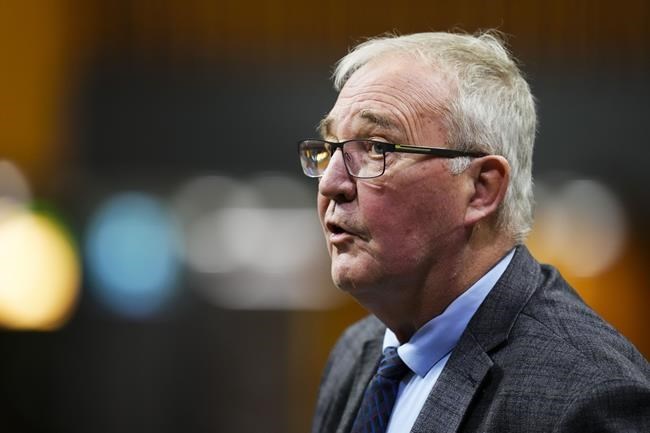ABBOTSFORD, B.C. — The mayor of Abbotsford says the British Columbia farming community has come a long way since devastating flooding in 2021 — but still has far to go with long-term recovery and repairing peace of mind for residents.
“People are very anxious,” Ross Siemens said Thursday. “Every time there’s a storm here you get a little nervous."
Siemens was speaking after a news conference announcing new federal disaster relief funding for the city. He said rebuilding roads and bridges damaged in November 2021 remains the community's top priority, and many residents worry about what the future holds.
Federal disaster assistance to help B.C. rebuild after the floods now exceeds $1 billion, Emergency Preparedness Minister Bill Blair said in Abbotsford. The city was among the hardest hit when atmospheric river events swelled rivers that spilled over, forcing thousands from their homes, inundating farmland and drowning thousands of livestock.
But he says that's still likely only a fraction of what the final aid package will be.
"They've had extensive damage," Blair said. "I've met with people who are still waiting to get back into their homes, who are in interim housing 14 or 15 months after this event."
The recovery is still a work in progress. Siemens said that in addition to fixing damaged roads and bridges, crews are still working to dig out ditches and culverts. Blair was in B.C. to make a second interim payment under the federal Disaster Financial Assistance program, through which Ottawa pays for the majority of recovery costs for major disasters.
The first payment for $469 million was made in July. The second payment Thursday is for $557 million.
But the federal government estimated last year it could ultimately cost more than $5 billion to rebuild the province after a string of natural disasters in 2021, starting with a heat wave and deadly wildfires in June and July, and then the flooding in November.
Abbotsford is considered the epicentre of the flooding disaster that devastated B.C.'s Fraser Valley. Several thousand people were forced from their homes in the community when a series of dikes were breached, sending water cascading into the city.
On Wednesday, Blair travelled to Princeton, B.C., about 160 kilometres southwest of Kelowna, where floodwaters ravaged the downtown and most homes are still under a boil-water advisory. The water treatment facility in the town of about 2,800 people was damaged in the floods and has yet to be rebuilt.
About 100 km north of Princeton in Merritt, B.C., displaced people are still waiting to move home. The city recently said it was buying temporary homes for some of those residents, using a portion of the $24 million it received from the province for flood recovery.
Federal disaster assistance kicks in once the cost of major events like floods and wildfires reaches a specific amount. That cost varies by the size of the province, with smaller provinces able to get more aid from Ottawa when disaster strikes.
In British Columbia, federal funding will cover 50 to 75 per cent after costs exceed about $17 million. Once the costs exceed about $88 million, Ottawa will pay for 90 per cent.
The Insurance Bureau of Canada said in a statement Thursday that the greatest severe-weather risk in the country is flooding, and the industry alone can't provide affordable coverage for those in high-risk areas.
Canada's insurance firms have provided the federal government with a proposal to create a national flood insurance program, it said.
"This program would ensure Canadians living in high-risk areas for flooding would have access to the enhanced financial protection that insurance provides, and allow for a speedier and more holistic recovery process."
The bureau said the November 2021 disaster remains the most costly severe-weather event in B.C. history at an estimated $450 million for insured damage.
Federal disaster payments don't cover costs that qualify for private insurance.
Siemens said there were many "sleepless nights" during the storms, and the new funding will leave the community more resilient.
“We’re in a better place than we were prior to the floods,” Siemens said. “We still have a ways to go long term, and we’re working on that.”
This report by The Canadian Press was first published Feb. 23, 2023.
— With files from Mia Rabson in Ottawa.
Darryl Greer, The Canadian Press



